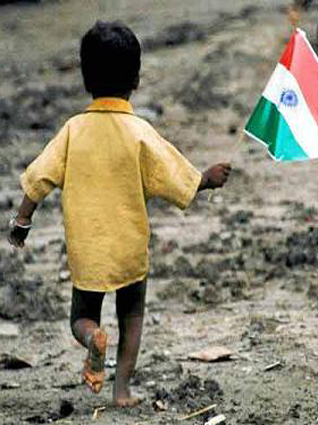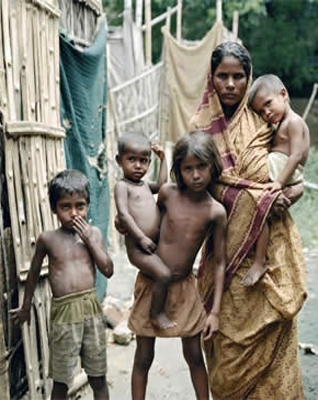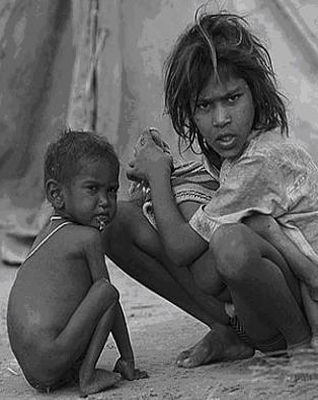Current Events
Incredible India v. Real India:
Dazzling Images Do Not A Shining Nation Make
by RAVINDER KAUR
In the past few years, residents and visitors to Davos, Switzerland, during the World Economic Forum (WEF) have become familiar with a spectacular annual phenomenon.
Streets, buses, cafés and even billboards in half empty parking lots are covered with colourful images of “emerging nations” competing with one another to position themselves as the “most attractive investment destination” in the world.
The most prominent players are some of the "BRICS" - mainly Brazil, Russia, India and South Africa - while China is conspicuous through its visual absence. This year, however, the dominance of these nations was broken by new players such as Mexico, Thailand and even Azerbaijan which mounted dazzling image campaigns to attract investor eyeballs.
The main streets of Davos turned in effect, into a site for exhibiting these “emerging nations” in a never ending mobile exposition of seductive images.
While the idea of nation branding to enhance competitiveness in global market has become unremarkable and ubiquitous by now, it is yet to be seen as part of nation making in the postcolonial world.
The history of contemporary India offers a keen insight into the shifts that have rearranged the very idea of postcolonial nation making. To begin with, nation building in post-Independence India has for long been linked to the “temples of modern India,” as Nehru tellingly described the massive infrastructure building that was expected to become the backbone of a prosperous nation as it transitioned from an agrarian to an industrialised one.
This emphasis on materiality has undergone a
fundamental shift in the past two decades of economic reforms. Now the
idea of nation-making, first and foremost, has become a matter of
“image” rather than concrete in the Nehruvian sense. The strategy of the
Indian state is clearly no longer limited to building infrastructure
alone; it has moved to a domain where the production and projection of
images of a prosperous nation has become as imperative a task as the
creation of a prosperous nation itself.
Social Entrepreneurs
This
emphasis on images is no better illustrated than in Davos where the WEF
meets every January. The annual meeting is a gathering of WEF members
comprising corporations worth more than $5 billion that are said to
“drive the world economy forward,” political leaders and established
NGOs.
In recent years, a new category of people called “social entrepreneurs” has been added to show that more benevolent sides of capitalism exist, especially when the notion of free markets is being challenged in the prolonged aftermath of the financial crisis.
The attraction of Davos lies in the fact that corporations gain direct unhindered access to heads of government and policy-makers who in turn covet any possibility of attracting investments. This is not particularly surprising given that success of the nation is now increasingly measured on its ability to attract foreign investments rather than welfare of its people and territorial security alone. Thus, the intense focus on creating attractive images of nations as worthy recipients of the global investor's attention.
In many ways, India has been a frontrunner in this trend of image making.
As part of the economic reforms in early 1990s, the state had already set up a specific agency to “brand” Indian products for the export markets. This project of branding “made in India” goods took a fresh turn in the first half of the 2000s when India, the nation, itself was turned into commodity.
In 2006 a freshly branded India made a spectacular entry in the world of global corporate investors through a colourful and ubiquitous campaign called “India Everywhere” in Davos. The introduction of a reformed India to the global elite began with dazzling posters, gigantic billboards, advertisement on buses, and facts and figures about “new” India.
The effectiveness of this campaign is still recalled by nation-branding specialists. Each year, since then, India has had a major visual presence at Davos through cleverly pitched campaigns designed by highly creative advertising agencies.
The India visible in the branding images primarily exists in the consciousness of the elite. It is a world of neat shopping malls, expensive branded products, happy, prosperous consumers, skilled scientists and engineers, white coats, headphones, smooth highways, high rise buildings, glass facades and green grass that paves one's vision.
The images could be from anywhere in the world, while the Indian setting is presented through cultural icons such as bindis, colourfully decorated elephants, Gandhiji's spectacles and Taj Mahal. In short, India is transformed into a global place while still retaining its cultural authenticity and ethnic appeal.
While this vision is a powerful tool to attract investors and tourists, it is also its biggest weakness.
The images conjure a world that does not really exist outside the limits of the visual frames.
Absent from the frames is
the “other” India - the poor, the untouchables, the minorities, and all
that is un-beautiful - the ruptured body of the nation that has not
only failed to “catch up” with the progress, but in fact is seen as
holding the nation back in its journey towards prosperity and global
power.
N11 Nations
It is not uncommon to
hear stories of shock and disappointment upon arrival from the very
members of the privileged global class that the Indian state so wants to
attract.
Not surprising, as the questions of poverty, inequality and social inequity in India remain as much part of the Indian growth story as the middle class prosperity despite their effacement from the image world.
As if to compensate for this gap, Indian political and corporate leaders have begun to pepper their sales pitch at Davos with the agenda of “inclusive growth” and the need for equal distribution in a society. Despite high growth rates over the past decades, India remains at the bottom of BRICS in terms of income disparity and human development of its citizens.
These inconvenient facts continue to disrupt the spectacle carefully manufactured for an external audience.
Thus, the simulated image of a world peopled with happy, well-nourished, cheerful and skilled Indians who are ready to work long hours at low wages has its limits. These limits become apparent at a time when India no longer seems to be the only high profile actor engaged in the art of image making.
Nations like South Africa and Brazil have been quick to move in to the field, followed closely by yet another newly minted group of nations, the N11, the termed coined by the imaginative Goldman Sachs bankers. The idea of ‘India Everywhere' has instead become a case of “Everyone Everywhere,” as one Indian anchor covering Davos put it.
As the novelty of dazzling image campaigns levels out, India might need to rework its agenda - to focus on the actual production of a prosperous and equitable nation, rather than producing merely images of it.
The author is Associate Professor of Modern South Asian Studies at The University of Copenhagen.
[Courtesy: The "Hindu" Newspaper.]
February 10, 2012
Conversation about this article
1: Singh (London, United Kingdom), February 10, 2012, 9:28 AM.
As for the economic growth India wants for the high population it has, it is better off generating it internally rather then chasing it abroad. With the high level of people out of work, with no source of income, if India generates business and private means to employ its people, it can achieve real growth. Internal growth has to also start with education, such as extensive vocational. The majority of the country survives incredible conditions and consists of remarkable people; we should help them rise above the level of stray dogs to lives of human beings. To aid the expansion of small business, government assistance should be in several ways to also provide housing and clean water. There are always ways, even with government assistance, to improve distribution of food and medical supplies to the needy rather than stuffing wealth in the pockets of politicians. Only honesty, hard work, truth, care, selfless service to others, will help. Humans depend on each other's compassion to live.
2: Baldev Singh (Bradford, United Kingdom), February 10, 2012, 9:57 AM.
What they should have is DAVOS-type meetings annually, urgently discussing contraception, political violence, sectarian violence, persecution and genocide of minorities, boy-child preference, superstitions, sacrifices of animals and children to Hindu deities, caste-based violence, nepotism, slavery, forced marriage, public hygiene, population contril, alcohol and tobacco abuse ... now, that would be incredible!
3: Lakhvir Singh Khalsa (Nairobi, Kenya), February 10, 2012, 10:27 AM.
We just returned home from a 3-week holiday in India and it left a bad after-taste on both arrival and departure at the hands of Indian immigration officials who are a bunch of illiterates, and who couldn't care less for the negative impact they leave with visitors to their country. If these are the kind of jokers India thinks are best suited for the job, the country can continue to market itself as "incredible" in its manufactured images which hide it's ugliness under all that fake makeup! This is not just our experience alone; if a proper investigation is carried out, you'll find that this is the rule, rather than the exception, at the Delhi airport and no one really gives two hoots of how they talk and treat travelers ... its like they are at a local train station! If I am not wrong, I think this apathy is further magnified against Sikhs ... and we did not notice a single Sikh official in the whole airport.
4: Gobinder Singh (U.S.A.), February 10, 2012, 6:21 PM.
I actually went to Taj Mahal for the first time recently. While the monument itself is magnificent, the roads to get there were in very poor condition with literally no signs to the world famous landmark which attracts millions of international visitors. Once you turn off from the main road into the city of Agra, the real India starts. Same story everywhere else. The main road from Delhi to Punjab (G.T. Road) is getting a face lift and multiple lanes are being built. But once you are off the road into the towns anywhere in India, it's like nothing has changed since time immemorial.
5: Kanwarjeet Singh (U.S.A.), February 10, 2012, 7:18 PM.
India - the land where millions are donated to stones in temples while millions of God's living creations perish due to hunger. What more needs to be said.
6: Sunny Grewal (Abbotsford, British Columbia, Canada), February 10, 2012, 9:44 PM.
What I don't understand is why India can't remain a nation of villages and farms and still prosper. All the government has to do is supply the infrastructure and access to education to allow people to live traditional lives with increased dignity. The solution is not to stick the next generation into factories to crank out doo-dads and gadgets which pollute the land and also enslave the nation to western consumerism. Could you imagine a Punjab where the roads have no potholes so that the farmers can get their goods to market faster? Or a Punjab where every farmer is aware of the most advanced up to date farming methods that don't rely on sucking the water table out of existence?
7: Roop Dhillon (Reigate, United Kingdom), February 11, 2012, 11:24 AM.
India will never change. If those of us who have been brought up abroad were to return to India and rule, that might change things ... But that is akin to saying India only obeys systems when a foreigner rules them ... Seems like self-rule by desis will always mean exactly what you see now ...






